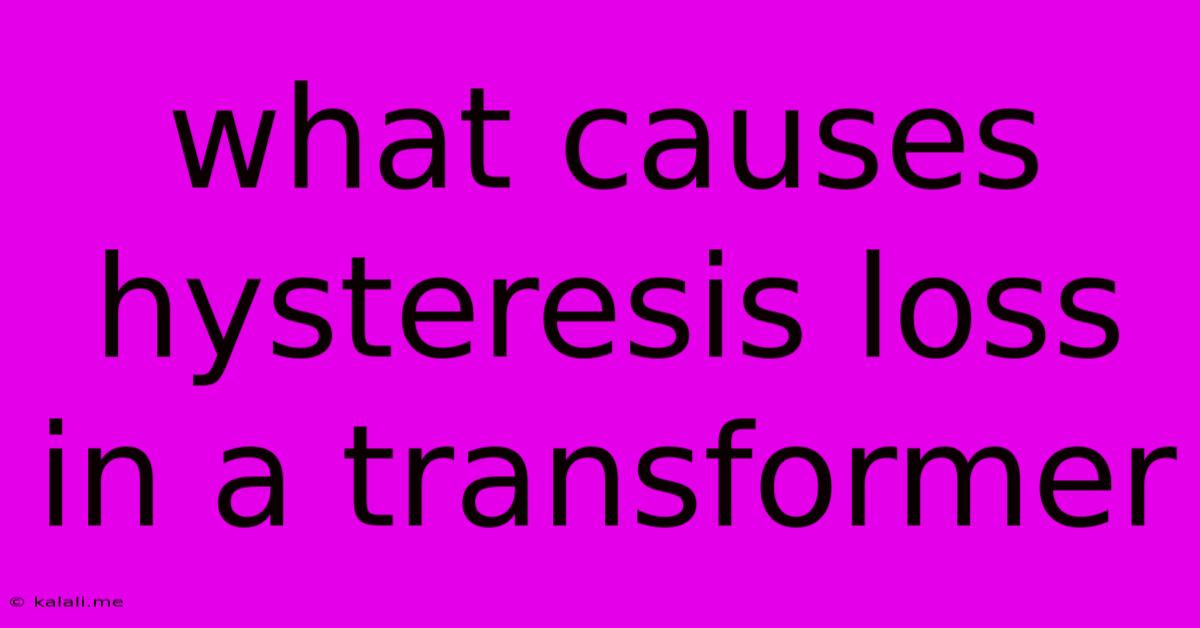What Causes Hysteresis Loss In A Transformer
Kalali
Jun 15, 2025 · 3 min read

Table of Contents
What Causes Hysteresis Loss in a Transformer?
Meta Description: Understanding hysteresis loss in transformers is crucial for efficient design. This article explores the core causes, including magnetic domain reversal and the impact of material properties, offering clear explanations and practical implications.
Transformers, essential components in power transmission and distribution, are not perfectly efficient. Energy is lost through several mechanisms, one of which is hysteresis loss. This article delves into the fundamental reasons behind hysteresis loss in a transformer, explaining the phenomenon in a clear and concise manner.
Understanding Magnetic Domains and Hysteresis
At the heart of hysteresis loss lies the magnetic behavior of the transformer core material. The core, typically made of ferromagnetic materials like silicon steel, is not a uniform magnetic entity. Instead, it's composed of numerous microscopic regions called magnetic domains. Each domain acts like a tiny magnet, with its own magnetic moment. In an unmagnetized state, these domains are randomly oriented, resulting in a net magnetic flux of zero.
When an alternating current (AC) flows through the transformer's primary winding, it generates a fluctuating magnetic field. This field attempts to align the magnetic domains in the core material along the direction of the field. However, this alignment isn't instantaneous. It requires energy to overcome the internal forces holding the domains in their original orientations. This energy is the source of hysteresis loss.
The Hysteresis Loop: A Visual Representation
The relationship between the magnetizing force (H) and the resulting magnetic flux density (B) in a ferromagnetic material is not linear but rather forms a characteristic loop known as the hysteresis loop. This loop demonstrates the energy lost during each cycle of magnetization and demagnetization. The area enclosed within this loop is directly proportional to the hysteresis loss per unit volume of the core material.
- Magnetization: As the magnetizing force increases, domains align, leading to a rise in magnetic flux density.
- Saturation: At a certain point, most domains are aligned, and further increases in magnetizing force result in minimal changes in flux density.
- Demagnetization: As the magnetizing force decreases, some domains resist realignment, resulting in a lagging magnetic flux density.
- Residual Magnetism: Even when the magnetizing force reaches zero, some domains remain aligned, resulting in residual magnetism (remanence).
- Coercive Force: A reverse magnetizing force is required to completely demagnetize the material. This force is known as the coercive force.
The loop's shape reflects the material's properties. A narrower loop indicates lower hysteresis loss, while a wider loop signifies higher losses.
Factors Influencing Hysteresis Loss
Several factors contribute to the magnitude of hysteresis loss:
- Material Properties: The type of core material significantly impacts hysteresis loss. Materials with narrow hysteresis loops, such as grain-oriented silicon steel, exhibit lower losses compared to materials with wider loops. Improved manufacturing techniques leading to better grain alignment contribute to this.
- Frequency of the AC Supply: Higher frequencies lead to more rapid changes in the magnetic field, resulting in increased energy expenditure to reverse the magnetic domains, hence higher hysteresis loss.
- Flux Density: Higher flux densities necessitate stronger magnetizing forces, leading to a larger hysteresis loop and increased energy dissipation.
Minimizing Hysteresis Loss
Reducing hysteresis loss is crucial for improving transformer efficiency. This can be achieved through:
- Using Suitable Core Materials: Selecting core materials with narrow hysteresis loops is paramount.
- Optimal Design: Careful design of the transformer core, including considerations of core geometry and winding arrangements, can minimize flux density and improve efficiency.
In conclusion, hysteresis loss in a transformer arises from the energy required to reverse the magnetic domains in the core material during each cycle of magnetization and demagnetization. Understanding the factors that influence this loss is crucial for designing efficient and effective transformers. Minimizing hysteresis loss directly translates to reduced energy consumption and improved overall performance.
Latest Posts
Latest Posts
-
Do Satellites Use Radio Waves Or Microwaves
Jun 15, 2025
-
Relationship Between Mass And Acceleration And Force
Jun 15, 2025
-
The Asteroid Belt Is Located Between Which Two Planets
Jun 15, 2025
-
1st Indian To Climb Mount Everest
Jun 15, 2025
-
Which Of The Following Is Not Used As An Antiseptic
Jun 15, 2025
Related Post
Thank you for visiting our website which covers about What Causes Hysteresis Loss In A Transformer . We hope the information provided has been useful to you. Feel free to contact us if you have any questions or need further assistance. See you next time and don't miss to bookmark.